JU 52 Souda Bay Crete
-
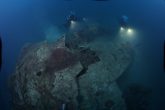
The German transport aircraft ju 52 as it is today at the bottom of Souda (Nikos Giannoulakis Archive) -

The main body of the aircraft is completely covered with nets (Nikos Giannoulakis Archive) -

The transport Ju 52 seen from a northerly direction (Nikos Giannoulakis Archive) -

The Ju 52 aircraft seen from a southerly direction. Two of the three engines are visible (Archive Nikos Giannoulakis) -
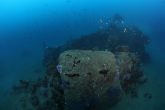
One of the three engines with the heat exchangers for cooling the engine oil (Nikos Giannoulakis Archive) -
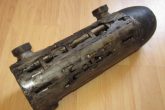
The heat exchanger for cooling the engine oil (File stackexchange.com) -
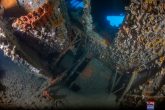
Image from the interior of the ju 52 (Nikos Giannoulakis Archive) -
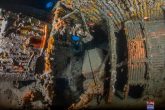
Close-up of the interior of the ju 52 at the bottom of Souda (Nikos Giannoulakis Archive) -
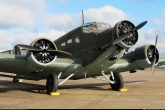
The ju 52 with the alternators under the engines (Krysztof Kaczala Archive) -
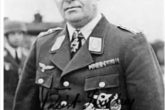
Luftwaffe General Kurt Student (1890-1978). He conceived the idea of creating paratrooper units and the construction of DFS 230 gliders. He was the mastermind behind the air attack to capture Crete (Operation Mercury) and was responsible for thousands of deaths. -
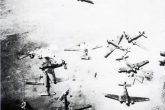
Downed Ju 52 aircraft at Maleme airport. -
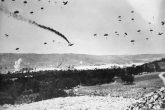
Amidst paratroopers dropping, bombing and anti-aircraft fire, the downing of a Ju 52/3m during the Battle of Crete is visible. -
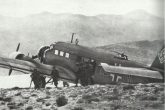
A Ju 52/3m paratrooper aircraft lands reinforcements at the captured Maleme airport. -
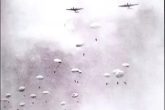
Ju 52/3m aircraft in formation drop paratroopers during the Battle of Crete. -
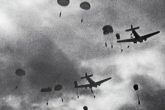
Paratroopers dropped during the Battle of Crete from Ju 52/3m aircraft. -

Video from the wreck of JU 52 in Souda Bay
On December 3, 2022, Antonis Grafas’ diving team, in collaboration with the well-known diver Nikos Giannoulakis, dived in Souda Bay, Crete, with the aim of researching, documenting and highlighting a wreck, which was identified as a German three-engine Junkers Ju 52 transport aircraft. The four-member diving team, consisting of Giorgos Kokaroudis, Yannis Liardakis, Nikos Giannoulakis and Antonis Grafas, made a total of four dives, managing to document the wreck, but without achieving its absolute identification, which would only be possible by finding the aircraft’s production number (German “Werknummer”). Unfortunately, the long duration the wreck has been at the sea bottom, the limestone coatings that covered the aircraft over the years, and the electrolysis, did not make it possible to find the plaque where the production number and other details of this particular aircraft are written. However, the research data, along with the other data the team managed to collect, showed that in the recent past the aircraft was moved from a greater depth, by a trawler, and left to rest at the point where it is located. This view is mainly supported by the presence of remains of a trawl net on the wreck and the complete absence of one wing of the aircraft.
The German three-engined transport Junkers Ju 52 represents one of the most iconic types of aircraft that were mass-produced and supported the operations of the German army during World War II. In Greece, this type was used in two major military operations, the Battle of Crete in 1941 (Unternehmen „Merkur“), and the Battle of Leros in 1943 (Unternehmen „Taifun“). Apart from the first major military operation in Narvik, Norway, in 1940, where paratroopers were dropped on a large scale for the first time, the battles of Crete and Leros were the only operations in which German paratroopers were also dropped on a large scale. It is widely known that the German army suffered very heavy military losses in the Battle of Crete. The elite paratrooper corps in particular was decimated to such an extent that its operational activity was drastically reduced by the end of World War II. The Junkers Ju 52 transport aircraft were the ones that were used as the main means of transporting the paratroopers to the battle theaters. This is the main reason why many of them were lost in the area of Crete. Due to its strategic position, Crete became, immediately after its complete occupation, an important focal point for the strategic network of the German army of occupation, throughout the war. Both the airlifts and the convoys aimed, on the one hand, to maintain Crete as a strategic hub in the southeastern Mediterranean, and on the other hand, to support Rommel’s army, the Afrikakorps, on the Cyrenaica Front. Thus, during the period of occupation of the island, there were war losses, including many Junkers Ju 52 aircraft. This fact, combined with the sparse data in the loss entries of the German Luftwaffe war diaries (see Verlustliste des Quartiermeisters VI), leads to insurmountable obstacles in identifying the aircraft lost in the Cretan Archipelago area. In order to specify the problem and to illustrate the particular difficulty of the identification task, I quote here, indicatively, a series of Junkers Ju 52 aircraft, from the German war diaries, which were lost in the wider area of the island:
-Ju 52 with serial number 6914 and side markings 4V+HP, of Kampfgruppe z.b.V. 106, was lost in Crete, with all its crew, on 20.05.1941.
-Ju 52 with serial number 6315, of Kampfgruppe z.b.V. 101, was lost in Crete, by anti-aircraft fire, on 20.05.1941.
-Ju 52 with serial number 6504, also of Kampfgruppe z.b.V. 101, was lost in Crete, also by anti-aircraft fire, on 20.05.1941.
-Ju 52 with serial number 5404 and side markings 9P+EU, of Kampfgruppe z.b.V. 60, lost in Crete on 20.05.1941.
-The Ju 52 with serial number 6908 and the side markings 9P+MU, also of Kampfgruppe z.b.V. 60, was lost in Crete, with all its crew, on 20.05.1941.
-The Ju 52 with serial number 7060, of Kampfgruppe z.b.V. 106, was lost in Crete, by anti-aircraft fire, on 21.05.1941.
-The Ju 52 with serial number 6867 and the side markings VK+BL, of Kampfgruppe z.b.V. 104, was lost in Crete in May 1941.
-The Ju 52 with serial number 2390, of Kampfgruppe z.b.V. 50, lost in Crete on 01.06.1941.
-The Ju 52 with production number 7277, of Kampfgruppe z.b.V. 300, was lost on 05.12.1941, after a forced landing near Chania, Crete.
-The Ju 52 with production number 5847 and the side markings 9G+HH, of Kampfgruppe z.b.V. 400, was lost in Crete, with all its crew, on 12.12.1941.
-The Ju 52 with production number 7202, of Kampfgruppe z.b.V. 300, was lost in Crete, after being shot down by an enemy aircraft, on 12.12.1941.
-The Ju 52 with production number 5644 and the side markings TN+BR, of Kampfgruppe z.b.V. 500, was lost in Crete, with its entire crew, after crashing, on 19.12.1941.
As is evident from the indicative entries listed, the reference in German archival war sources, with the phrase “lost in Crete”, makes the identification of the Junkers Ju 52 aircraft of Souda, without finding the aircraft’s production plate, particularly difficult, even impossible. Only by finding the plate and with its production number clearly visible would an absolute identification of the wreck be possible. The only case where German sources specify the geographical point of loss, in one of the aforementioned Ju 52, is the case of the aircraft with production number 7277, of Kampfgruppe z.b.V. 300, which was lost on 05.12.1941 after a forced ditching near Chania, Crete. It is possible that this is the Souda aircraft, but without any evidence, such as the plate with the production number, this statement remains a mere guess.
The Junkers Ju 52 of Souda, whose identity has not yet been revealed, is another material historical witness to the fierce battles that took place in the Aegean during World War II. With the research and documentation carried out by Antonis Grafas’ diving team, it places another piece in the historical puzzle of the war events that took place in Greece, making it a special area of action that requires further investigation and research in order to highlight its undoubted historicity.
Dimitris Galon
The Wreck
The wreck of the JU-52 is located at a maximum depth of 32 meters, upside down, with one wing on the captain’s side detached from the fuselage as well as its tail section, allowing a diver with a sidemount setup to penetrate relatively easily through the cockpit door which “faces the Northeast axis”. Extensive efforts were made to locate the metal plate with the aircraft’s data, which unfortunately did not bear fruit. Information about the location of the wreck came to the attention of Nikolas Giannoulakis, through a local fisherman. Throughout the aircraft there are remains of nets (probably trawlers), which to some extent the divers who participated in the identification effort removed, in order to facilitate access to the internal parts of the fuselage.
Sources of historical photos:
(https://www.cretetip.com/maleme-german-military-cemetery/)
(http://worldwartwo.filminspector.com/)
(http://worldwartwo.filminspector.com/2017/10/conquest-of-crete-operation-mercury.html)
(https://www.cretetip.com/maleme-german-military-cemetery/)
(https://geetha.mil.gr/istoriko-afieroma-gia-ti-machi-tis-kritis/)
(http://worldwartwo.filminspector.com/2017/10/conquest-of-crete-operation-mercury.html)

